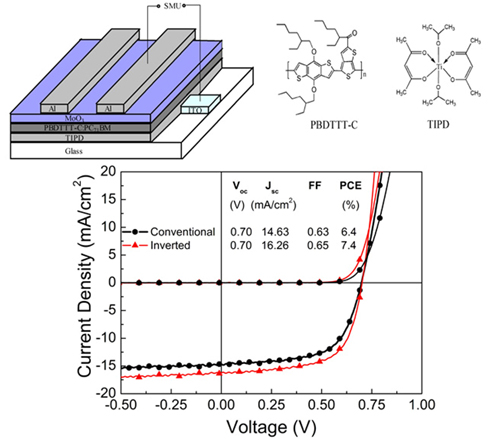Polymer solar cells (PSCs) have received considerable attention in recent years because of their potential application for low-cost solar energy conversion. The conventional PSCs are composed of a photoactive layer sandwiched between an indium tin oxide (ITO)/poly(3,4-ethylenedioxythiophene): poly(styrenesulfonate) (PEDOT:PSS) positive electrode and a Ca (or LiF)/Al low-work-function negative electrode. However, both the PEDOT:PSS layer and the low-work-function metal electrode are known to degrade the device lifetime, since the low work-function metal is susceptible to degradation by oxygen and water vapor, and the PEDOT:PSS layer is acidic and corrosive to the ITO electrode. Recently developed inverted PSCs solved the problem and improved the stability by using ITO modified by an electron-collecting layer as negative electrode and stable high-workfuntion metal top electrode as positive electrode. A key component in the inverted PSCs is the electron-collecting buffer layer material on ITO electrode. Solution-processing and low temperature treatment of the buffer layer is desirable for low cost and large area fabrication of the PSCs, especially for flexible PSCs with plastic substrate. However, the buffer layersuch as ZnO and TiO2 reported in literatures was prepared ether by vacuum-evaporation or with high temperature treatment (higher than 200oC) after solution-processing. Therefore, high efficiency solution-processed low-work-function buffer layer on ITO electrode still needs to be developed for high performance inverted PSCs.
Under the support of NSFC, Ministry of Science and Technology of China and the Chinese Academy of Sciences, the researchers in CAS Key Laboratory of Organic Solids, in collaboration with the State Key Laboratory of Polymer Physics and Chemistry and North China Electric Power University, fabricated the inverted PSCs based on PBDTTT-C/PC70BM with isopropanol solution-processed TIPD as electron collecting layer on ITO as negative electrode and air-stable MoO3/Al as positive electrode, as shown in Figure 1. The TIPD buffer layer was thermal treated at 150oC for 10 min, which removed the two isopropoxy groups in TIPD and turns the surface of the buffer layer from hydrophilic to hydrophobic. The power conversion efficiency (PCE) of the inverted PSC with a-TIPD buffer layer annealed at 150 oC for 10 min reached 7.4% under the illumination of AM1.5, 100 mW/cm2, which is increased by 16% in comparison with that (6.4%) of the device in the conventional structure. The high PCE of the inverted device is benefitted from the hydrophobic surface (which is beneficial to the active layer formation on it from the organic solution) and the suitable electronic energy levels (which facilitates electron collection and block hole transfer from the active layer to the negative electrode) of the a-TIPD buffer layer. Long lifetime can also be expected for the inverted PSCs with the stable a-TIPD buffer layer and MoO3/Al top electrode.
This work is the extension of their previous work on the TIPD buffer layer in a traditional PSC based on MEH-PPV/PCBM.

Figure 1. Device structure and J-V curves of the inverted PSC based on PBDTTT-C/PC70BM with TIPD buffer layer on ITO as negative electrode and MoO3/Al as positive electrode. (Image by Li Yongfang et al.)
